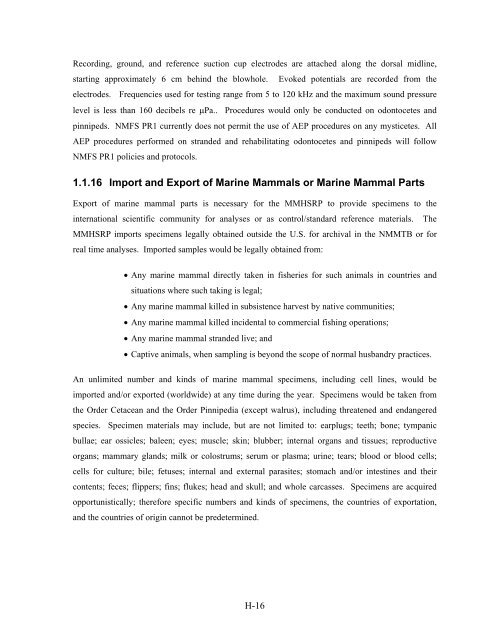Volume III, Appendices EM - National Marine Fisheries Service ...
Volume III, Appendices EM - National Marine Fisheries Service ...
Volume III, Appendices EM - National Marine Fisheries Service ...
Create successful ePaper yourself
Turn your PDF publications into a flip-book with our unique Google optimized e-Paper software.
Recording, ground, and reference suction cup electrodes are attached along the dorsal midline,<br />
starting approximately 6 cm behind the blowhole. Evoked potentials are recorded from the<br />
electrodes. Frequencies used for testing range from 5 to 120 kHz and the maximum sound pressure<br />
level is less than 160 decibels re μPa.. Procedures would only be conducted on odontocetes and<br />
pinnipeds. NMFS PR1 currently does not permit the use of AEP procedures on any mysticetes. All<br />
AEP procedures performed on stranded and rehabilitating odontocetes and pinnipeds will follow<br />
NMFS PR1 policies and protocols.<br />
1.1.16 Import and Export of <strong>Marine</strong> Mammals or <strong>Marine</strong> Mammal Parts<br />
Export of marine mammal parts is necessary for the MMHSRP to provide specimens to the<br />
international scientific community for analyses or as control/standard reference materials. The<br />
MMHSRP imports specimens legally obtained outside the U.S. for archival in the NMMTB or for<br />
real time analyses. Imported samples would be legally obtained from:<br />
• Any marine mammal directly taken in fisheries for such animals in countries and<br />
situations where such taking is legal;<br />
• Any marine mammal killed in subsistence harvest by native communities;<br />
• Any marine mammal killed incidental to commercial fishing operations;<br />
• Any marine mammal stranded live; and<br />
• Captive animals, when sampling is beyond the scope of normal husbandry practices.<br />
An unlimited number and kinds of marine mammal specimens, including cell lines, would be<br />
imported and/or exported (worldwide) at any time during the year. Specimens would be taken from<br />
the Order Cetacean and the Order Pinnipedia (except walrus), including threatened and endangered<br />
species. Specimen materials may include, but are not limited to: earplugs; teeth; bone; tympanic<br />
bullae; ear ossicles; baleen; eyes; muscle; skin; blubber; internal organs and tissues; reproductive<br />
organs; mammary glands; milk or colostrums; serum or plasma; urine; tears; blood or blood cells;<br />
cells for culture; bile; fetuses; internal and external parasites; stomach and/or intestines and their<br />
contents; feces; flippers; fins; flukes; head and skull; and whole carcasses. Specimens are acquired<br />
opportunistically; therefore specific numbers and kinds of specimens, the countries of exportation,<br />
and the countries of origin cannot be predetermined.<br />
H-16
















